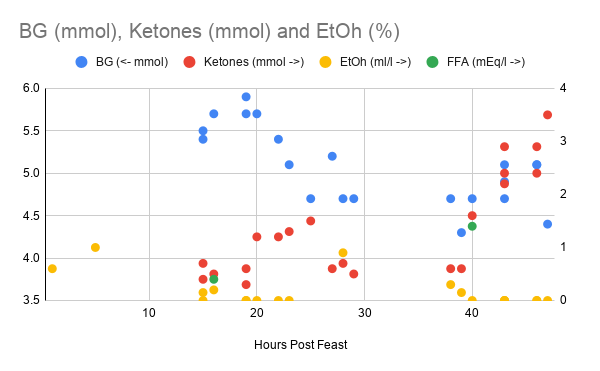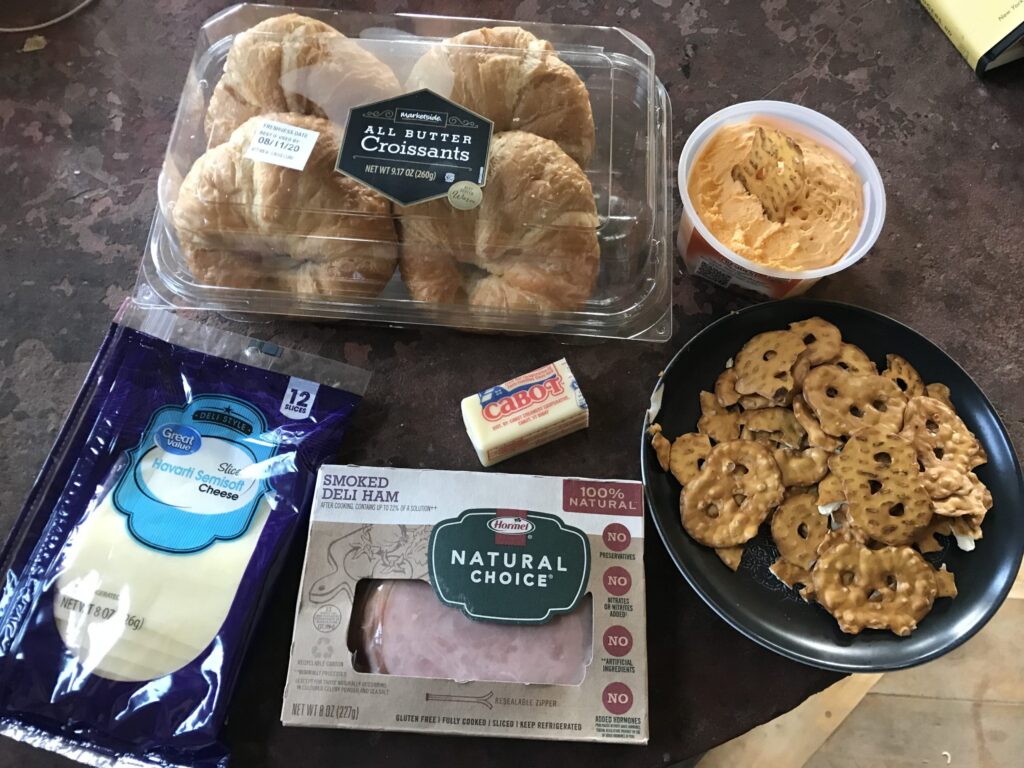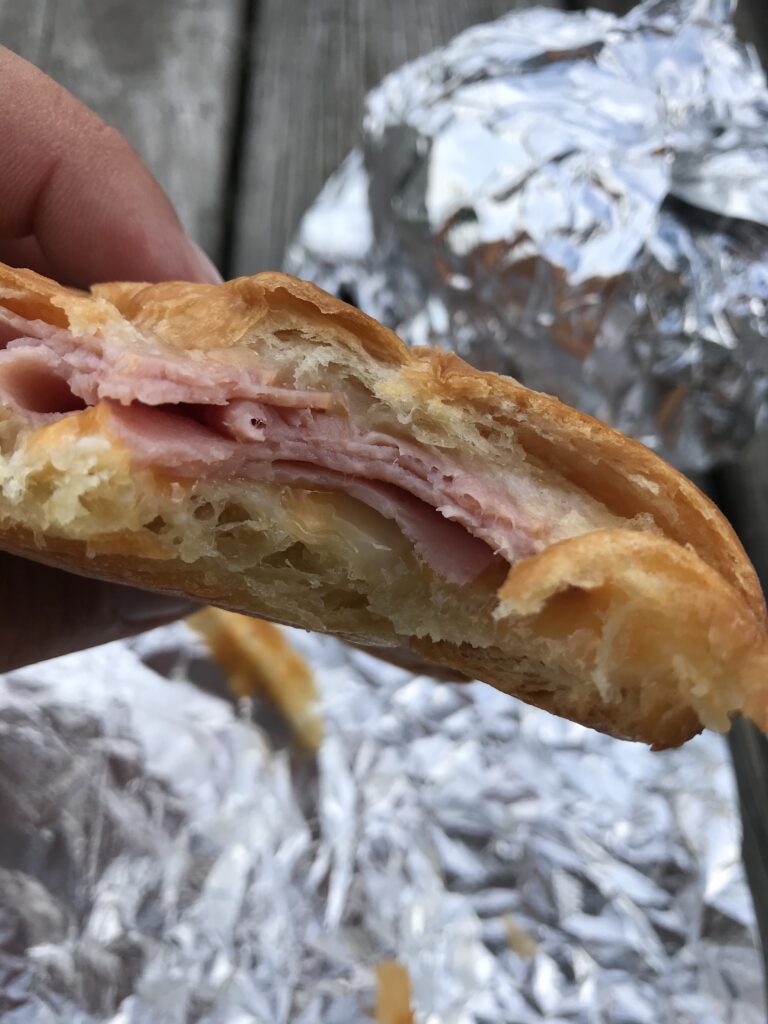I completed the first ten rounds – 20 days – of the Feasting Mimicking Diet without many issues. Hunger was greatest during the second day of the first cycle. I suspect that after the second or third cycle my liver glycogen was largely depleted. On days after a feast my blood sugar would be relatively high and ketones modest. After a fast day my ketones would rise rapidly until the next feast. Oh! And I lost weight.

Am I Diabetic Now?
After I announced the Feasting Mimicking Diet, some expressed concren that I would give myself diabetes by intentionally giving myself insulin resistance by consuming wine and saturated fat but then feasting on carbohydrates.
This is a reasonable and valid concern. I mean, I didn’t THINK I would but maybe? On days 19 and 20 I got bloodwork done at LabCorp in Scranton, PA. Shout out again to Dave Feldman and Siobhan Huggins over at ownyourlabs.com. While I was there I overheard someone walk in to get an Oral Glucose Tolerance Test. I thought, I should do that!
An OGTT works like this: You consume 75g of straight glucose and then test your blood sugar two hours later. If your blood glucose at that point is under 140, you are very insulin sensitive. If it’s over 200 you are considered to have type two diabetes. Anything in the middle is considering impaired glucose tolerance.
On my way home I stopped at the drugstore and bought a container of glucose tablets. There were so many different fruit flavors to choose from! I went with orange. The tablets are very large (4g of glucose each) and very sweet but with balance of tartness and good orange flavor. They remind me of huge SweetTarts. I had to crunch through 19 of them to get my dose of 76g for the test. It was 12 year old Brad’s dream. I might do more of these tests just for an excuse to eat so much candy all at once!
That’s a LOT of sugar and pure glucose hits your bloodstream FAST. I was coming off of a 44 hour period of fasting with wine as my only source of calories. An hour in my BG was at 245 and I was literally trembling. At the end of the two hour period my BG was at 180 – not diabetic but not far from it!
So I had successfully given myself insulin resistance. But here’s the key question. Because I am quite insulin resistant does that mean I’m on the road to diabetes? Luckily I collected a LOT of data this time.
| Day 0 | Day 19 Post Feast | Day 20 Post Fast | |
| Weight | 235 lbs | 219.6 | |
| Waist Circumference | 39.75 | 38.5 | |
| Fasting Blood Glucose | 111 | 105 | 86 |
| Fasting Insulin | 15.3 | 6.9 | 8.6 |
| Fasting Free Fatty Acids | 0.7 | 0.4 | 1.4 |
So I’d lost 15 lbs in 20 days, more than an inch off of my waist, my fasting blood glucose was lower and my fasting insulin levels were literally cut in half.
I was reversing symptoms of pathological, long term insulin resistance while remaining physiologically insulin resistant.
Let’s Talk Post-Prandial
During the feast I eat until I literally can’t take another bite. Obviously this is a large meal combining starch protein and fat and it takes a while to digest. On the one hand I’m insulin resistant going into it and on the other hand I know that combining starch with saturated fat and protein is the best way to get a maximal insulin spike. Afterwards I have that feeling like after Thanksgiving dinner where all you want to do is lay on the couch and watch football except there’s no football now. (If you’re reading this far in the future and wondering what happened to football, this was written during the Covid-19 epidemic.)
I have a blood glucose spike that lasts about four hours, peaking two hours after the meal around 190. I am probably producing a pretty fair amount of insulin during this spike. Is this bad? My gut says no. Insulin is an anabolic hormone that stimulates not only glucose uptake but also uptake of amino acids for building protein and ribonucleic acids for building DNA.1 Perhaps having a good bit around during the small window of the 48 cycle while protein is available is a good thing? I’m speculating here, but I am interested in thinking about how these seemingly opposing factors play out in the post-prandial period.
The fact that my Free Fatty Acids are low the morning post-feast suggests that insulin is indeed having effects. To channel Peter at Hyperlipid, “The function of insulin is the inhibition of lipolysis.” Lipolysis is the process by which fat cells release Free Fatty Acids.
The Other 44 Hours
A pretty regular pattern emerged over the rest of the cycle. I made a scatter plot! Who doesn’t love a good scatter plot?

Blood glucose is highest the morning after the feast. I assume this is due to a combination of lowish insulin and available liver glycogen. It starts to decline the afternoon after the feast and stays low until the next feast. Ketones are typically over 1 mmol/L by noon after the feast. I find this fascinating since the feast contains 150g of starch. Free Fatty Acids are low the morning after the feast but rise throughout the period. After wine consumption the evening of the fast day, ketones drop until the ethanol is cleared and then rise steeply the morning of the feast day.
Blood Glucose never gets low, presumably because I’m insulin resistant. The consistent presence of ketones and free fatty acids and/or ethanol means I’m never particularly hungry.
Back To Croissants
One of the complaints about this blog is that many of my ideas involve fairly elaborate cooking and exotic ingredients. Handmade croissants. Fat bomb fries. Stearic acid. Beef suet. But I’m going on a road trip! I figured this was the perfect time to come up with a feast meal using only pre-packaged, store bought ingredients. Something I could get from a national retailer…
And then I thought of the all butter croissants at Wal-Mart. Just like that I was back to Croissant sandwiches. Here’s the feast meal:

So for the new feast meal I attempt to eat everything in this picture. I assemble all four croissants into sandwiches using all of the butter, cheese and ham; wrap them in foil; pop them into the toaster oven and eat the cheese dip and pretzels while they cook. Incidentally, if you want a “cracker” with zero vegetable oil, the Snack Factory brand Pretzel Crisps are what I’ve been using. They also make a gluten free version. I usually can’t finish the fourth sandwich, but if I DID, this is how the macros would break down including 22 pretzel crisps (2 servings according to the bag):
| % of Calories | ||
| Calories | 3649 | |
| Protein | 132g | 15 |
| Carbs | 162 | 18 |
| Fat | 274 | 68 |
The best thing about this feast is that on a road trip you can heat up the sandwiches in the hotel parking lot under the hood of your car while the engine cools down. Because ‘Merica.

- 1.Hollenberg M, Cuatrecasas P. Insulin and epidermal growth factor. Human fibroblast receptors related to deoxyribonucleic acid synthesis and amino acid uptake. J Biol Chem. 1975;250(10):3845-3853. https://www.ncbi.nlm.nih.gov/pubmed/165185

Freaking amazing Brad!
Thank you! So much candy! 😉
Did you forget to include your wine calories or did you not partake?😂🤪
Bravo Brad!
I gotta ask, what is the hangover cure you are using? I want to drink that much wine with no regard for tomorrow.
Experience.
Thanks for sharing the packaged meal option and example. Not sure about the toasting option though!
To date it has worked fairly well on my road trip. It’s not quite as satiating long term as the higher stearic acid beef suet stuff, but I’ve continued to lose a little weight on a road trip, which is a feat in and of itself.
I know you mentioned before about consuming some things that don’t spike insulin to a great degree (heavy cream, bone broth) on your fasting days. Did you end up using any of that or was it only wine? I’m thinking of running this with mostly pancakes and 48 hour fasts, I’m quite lean (10-12% body fat) so I’m interested if it will have an effect being a bit leaner. Thanks for your experimentation, it’s very interesting.
I didn’t end up needing to use anything other than the wine. At 10-12% bodyfat, I worry that fasting might be hard for you. It works for me because I’m tapping into my fat reserves. Good luck, though!
How did you get the scatterplot data? Urine sticks? Blood glucose meter? Other? Or did you use a lab? I’m unfamiliar with measuring Etoh and FFA.
Good question! The Blood glucose and ketones were measured with a Keto-Mojo device. The insulin and FFA were measured with blood draws at labcorps that I ordered from https://ownyourlabs.com
Hey Brad — I thought the physiological insulin resistance induced by the saturated fat was specifically limited to fat cells. Is that incorrect? If not, couldn’t one do some amount of anaerobic exercise to accelerate muscle uptake of glucose and keep the muscle cells insulin sensitive (maybe sufficiently so to offset the fat cells’ resistance) and get glucose down (if desired)?
I think the SFA largely targets adipose. The long period between meals, I think, puts my muscles into what would call glucose sparing mode. They are out of the habit of taking up glucose and so they don’t. I have no problem with this, it just means I’m running on fat.
OGTT >140 at 2 hours meet criteria for pre-diabetes
Yes! That’s the thing. The point is to show the difference between physiological and pathological IR. My resting insulin of ~8 and my fasting blood glucose of 86 the morning of that test show that I am clearly not hurtling towards diabetes. But I AM IR in the short term as proven by the OGTT. Context matters!
Hey Brad, I’ve been working my way through your website. I’ve got a background in biology, so it’s not impossible to follow. My questions are around carbs, saturated fats, and PUFA/MUFA effects on energy metabolism. My life experience anecdotes are: I lived in Germany for 6 months as a teenager and ate huge amounts of butter and cheese with bread and lost weight. My host family were all skinny and ate this way too. I had gestational diabetes with my first pregnancy 7 years ago, and eating takeaway food always spiked my blood sugar regardless of portion control for the calculated carbohydrate effect. Do you have a mechanism to explain how PUFA/MUFA disrupts both fat and carbohydrate metabolism? I know people who eat tons of carbs and just burn them all up fine, stay skinny and have Appetite control. And I’ve tried keto and low carb multiple times over the past few years, and my major setback is always that I have no energy – my body can’t seem to switch to just using fat. And carnivore – I can eat 4 steaks with butter and still not feel “satisfied” – I just get sick of eating meat. This diet thing is such a puzzle. Also, have you looked at Dr Chris Knobbe’s talk? He’s asking the same lines as your research https://youtu.be/7kGnfXXIKZM
The anecdote about Germany is interesting and matches the pattern seen around the world, even in the US before the explosion of vegetable oils.
There are a lot of variables in the idea that takeout food spikes your blood glucose. That’s a tough one to unpack without more info. I will say that I do believe the end stage of combining vegetable oil with starch is type 2 diabetes. The mechanisms for this are complex.
Thanks for the store-bought feast idea. Maybe I’m missing something here, but isn’t grocery ham full of PUFAS?
Love your blog!
As a percentage of fat it would be, but since it’s 90% lean ham, it doesn’t affect the overall ratio that much.
Hi Brad your work and thoughts are absolutely fascinating. I am about to have a go myself and have literally never been this excited about a diet!
But I have question about your stearic acid butter oil. It is in liquid form but many of the recipes need a cold, firm fat (croissants, pastry etc). How do you incorporate the oil into those or do you use something else for that?
Thanks! I will let you know if I can replicate your success.
Oh, don’t worry, after it cools down it becomes VERY firm.
Brad, do you have a plan for coming off this and moving into a maintenance mode? I am day 2 of cycle 3 and feeling much better. Day 2 was much easier on this 3rd cycle. I have lost 5 pounds (probably more – I seem to lose 3-5 on the 2nd day each time). Guess I am looking to the future and what eating will look like! Maybe just one meal a day after I hit my target weight? Or one small meal at lunch and then a larger dinner? Thanks for the feedback!
Hi Melissa!
I’m glad this is working and yes, the fasting gets easier with time. As to my maintenance plan when I hit target weight…
I have a vague notion of following the eating plan of the chef Elizabeth David, who recommended black coffee in the morning, a light breakfast around 11am and then seven hours before dinner. That sounds nice! Probably with a fast day per week thrown in.
Brad
Hi Brad,
So you lost another 8 kilo’s eh?
Gets a bit old buying new pants all the time doesn’t it.
I bought new ones end of june and the same ones again 7 weeks later because I was hoisting them up all day. It’s a costly diet this one.
I’m working myself up to do this feast fast, but I’m just not able to eat that much food in one sitting.
I could try to do it in two meals. Does that spoil things because then I have two insulin spikes?
By the way, for a die hard low carber like me it’s really weird to look at your road trip meal picture and realise that with its 18% it’s actually low carb!
(Let’s not discuss here if a onion maybe has more vitamins than a croissant)
On the road trip I used store-bought all butter croissants. Many times I cheated on the feast-fast cycle, so it was more like feast-feast fast. I had a lot of meals of brisket and Mac-n-cheese because I toured BBQ joints across the country and that seemed like the best TCD ratios. I was on the road for two weeks and came back a half-kilo lighter and lost a half inch on the waist.
Pretty good results!
Tried mixing butter and organic cocoa butter (3:1). Even tried the 100g Lindt 90%+ 100g cocoa butter + 50g butter dessert. Was nice until i started visiting the bathroom 5 + times/day. I am lactose intolerant but could always tolerate butter but not this combo or volume. Gained 2 lbs even so. Don’t drink alcohol.
Too bad, was hoping it would work for me. Have had IBS for decades.
Is it worth trying Suet? Thinking about it.
Interesting, I wonder if it could be a reaction to something in the chocolate?
Hi Brad. I found your website and N 1 personal experiment fascinating. Do you think the mechanism will work using store bought high quality bread that does not have any seed oils slathered in butter? Also, have you thought about eliminating seed oils and increasing the saturated fat on a ketogenic diet? I personally follow a low carb diet but my 8 year old son loves breads and carbs. I am thinking this could be a healthy way for him to eat his bread and still maintain his health. Thoughts? Thanks for your efforts.
If your metabolism is relatively healthy, it’s really hard for me to argue against bread and butter, knowing that iterations have fed EUropeans, Americans, Asians and Africans for hundreds and in some cases thousands, of years.
Brad, are you familiar with the Microsomal Ethanol Oxidizing System (MEOS)? Seems like it could be playing at least some part in all of this. Very interesting. I’m going to go buy some more wine.
I’m familiar. I’m not sure of its relative importance.
Brad, why are you hiding my post? filtering negative reactions to your diet? shame on you
Not hiding! I just have to moderate the posts to prevent spam, I was traveling and it took me a bit to get to it.
If I’m lazy and don’t want to mix the stearic acid or bake it in can i just add it to water and drink it during a meal?
The biggest concern here is whether you can absorb it. The melting point is 170 degrees. The acids in your stomach will help, so… Maybe?